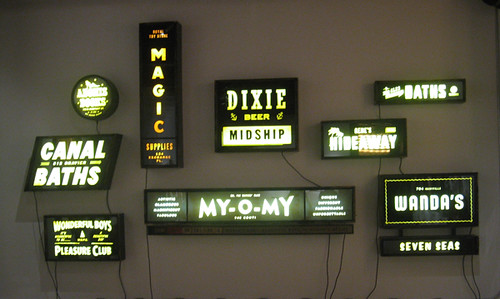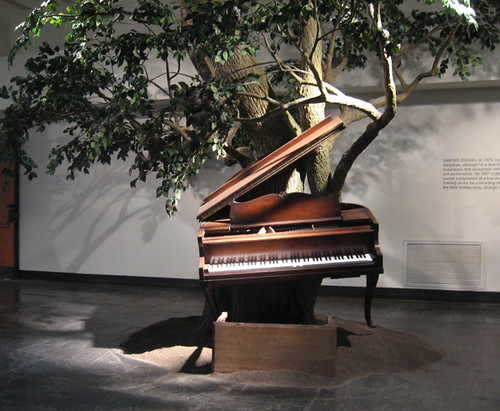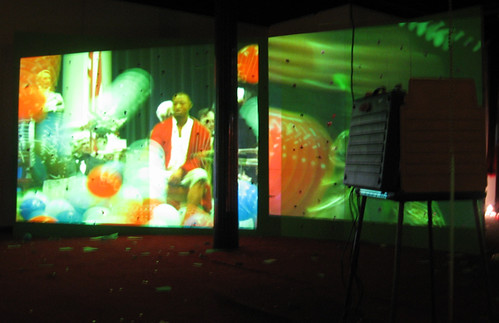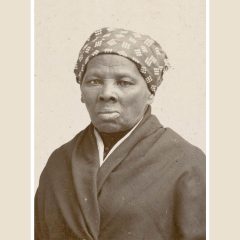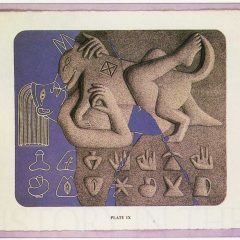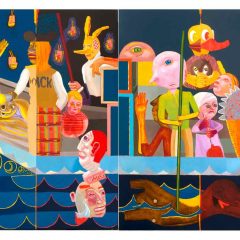Post by Cheryl Harper
Prospect 1 New Orleans is the newest world biennial and the largest in the United States. The organizer, Dan Cameron, envisioned a showcase for cutting edge international artists throughout the recovering city while providing significant opportunities for New Orleans artists. The idea is to bring serious art tourists to the city during this and four future biennials, and thus gain a foothold for an American version of the Venice Biennale. Prospect 1 sets itself apart from the commercial Art Basel even though their calendars somewhat overlapped. The longer Prospect 1 closes January 18, 2009. The combination of high and lowbrow sites was intriguing and for the most part, accessible. I used the Prospect 1 shuttle to get around to most locations.
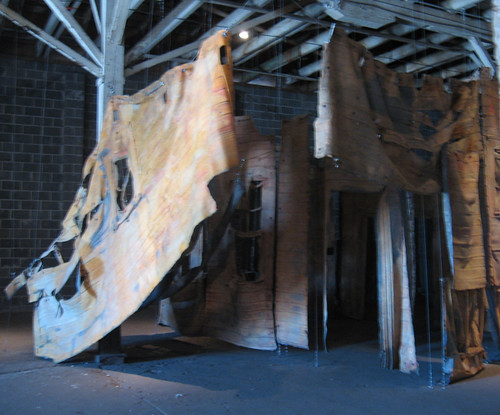
Takashi Horisaki’s Social Dress New Orleans
In this first incarnation, 81 artists participated, all international save for 12 from New Orleans. The unofficial theme was artists responding to Hurricane Katrina. As all current events must, interest in them wanes as they enter the realm of history. It is too soon to evaluate the storm and its aftermath from a historic perspective and too late for many of the artists to incorporate the rawness of the event as it unfolded. For me, only a few of the Katrina themed works resonated, one being Takashi Horisaki’s Social Dress New Orleans. This work is a sectioned rubber mold of a lower 9th ward home, just before demolition. Like the work of Rachel Whiteread, the molded version took on a new identity. Installed in a dark warehouse, the specter of something that communicated “house” hung like moss from timber beams.
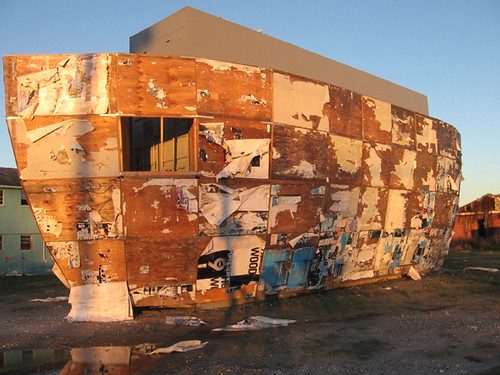
The concept of boats and arks appear sporadically in various venues of the biennial. The largest is Mark Bradford’s colossal construction, Mithra, in the lower 9th ward. The ship looms large even in the desolate, but previously densely populated area. An New Orleans friend familiar with the piece described the work as somewhat baffling for the neighborhood’s displaced residents, who regularly attend church. In the biblical story, only the righteous had access to the ark. And here, this immense “art ark” reminds them that the lord chose not to save them. According to Bradford, the work is not a reference to Noah, but it is impossible, given the location, to see it otherwise.
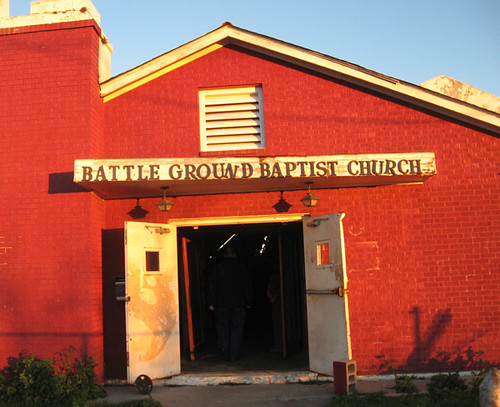
Nari Ward’s Diamond Gym (outside)
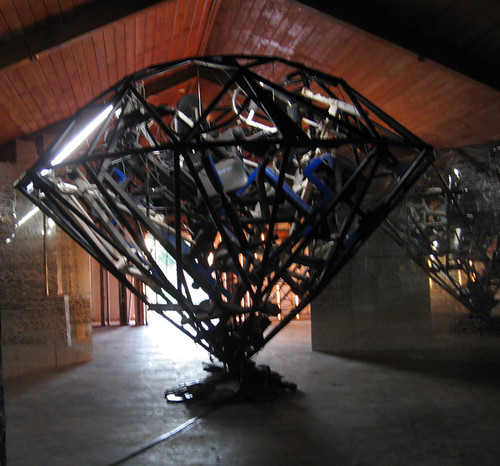
Nari Ward’s Diamond Gym (inside)
A poignant work that respects the neighborhood’s sensibility is Nari Ward’s Diamond Gym, incorporating a historic lower 9th ward congregation’s building into his piece. Sitting on abandoned pews, one observes a monumental diamond shaped cage filled with the detritus of aerobic machines and other out of context exercise equipment. Conceptually, the bodies were lost, but the souls endured.
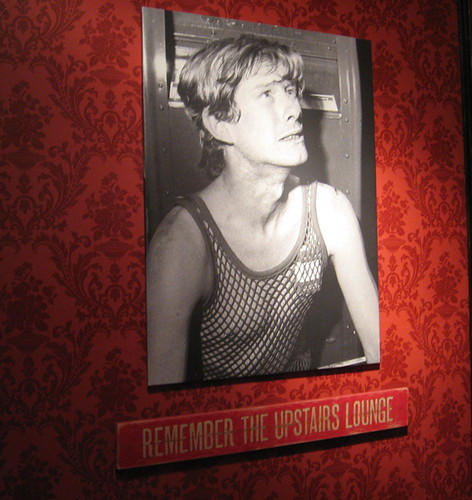
Skylar Fein, from the installation Remember the Upstairs Lounge
Another New Orleans themed work with a longer historical reach is the emotionally charged work by Skylar Fein, Remember the Upstairs Lounge. It grabbed me by the throat and demanded I consider the ramifications of a horrific 1973 fire in a gay bar in the French Quarter. After one enters the installation through swinging bar doors into the faux, flocked wall papered hallway, a simply hung line of unadorned photographs of before, during, and after the fire, resurrected the scene.
The project continues with an assault of iconic images from the homoerotic French Quarter of the 70s: a beefcake Mark Spitz; a small encased copy of the Farnese Hercules, once a kitsch object at the original bar, and now a precious surviving artifact; a peep show booth with news footage of the fire; backlit business signs; and period pop music all competed for attention before I exited through another set of swinging bar doors.
Prospect 1 included glitzy works on loan from New York galleries that would have been more at home at Art Basel and a number of international works that made little sense outside their context. Many works had been commissioned for the biennial, and some of those had a rushed, flamboyant feel to them. An exception was Sanford Biggers’ haunting Blossom. It appeared as if a baby grand had slammed into great tree during the hurricane and landed upstairs at the U.S. Mint building. The player piano intermittently played an arrangement of Billy Holliday’s “Strange Fruit”. It was simultaneously simple, complex, elegant, and unnerving, appropriately New Orleans, Katrina, but with a message beyond both.
There are video and multi media works ranging in appeal, the strongest I saw included Stephen G. Rhodes, Who Farted !?!!?!??!!?! (Interregnum), a complicated multiple video/installation riff on Disney’s Hall of Presidents animatronics display. William Kentridge’s What Will Come (has already come) was cleverly enigmatic; a Kentridge evolutionary drawing projected onto a mirror that distorted onto a moving disk that reflected accurately back onto a mirrored tube. The intimate technically sophisticated piece was beguiling in the dark interior of an old shotgun house.
—Cheryl Harper is an artist and curator. You can see her art in the upcoming Obamarama show at Projects Gallery.


